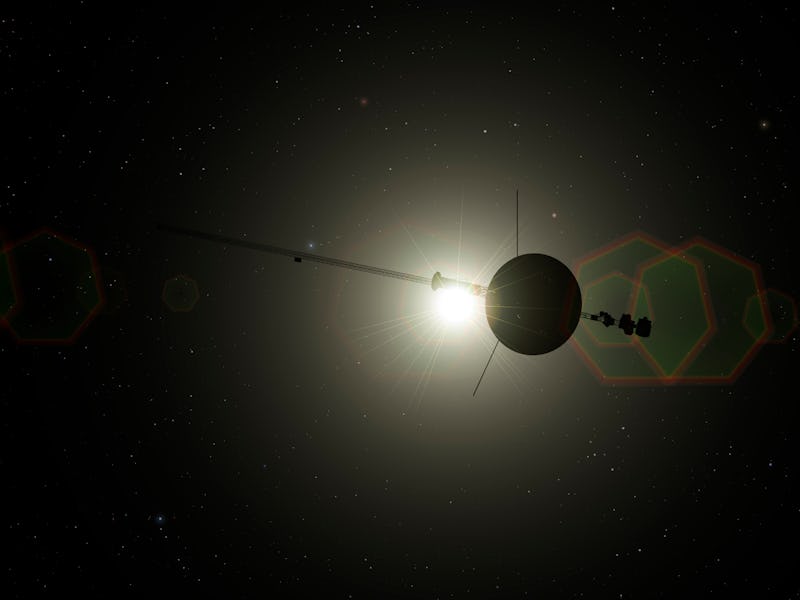Have aliens visited Earth? These scientists want to look for their trash
An alien civilization may have already sent a probe to study our planet.

On September 5, 1977, the Voyager 1 space probe launched into space. As the mission was bound out of the Solar System, NASA packed Voyager 1 (and its companion, Voyager 2) with a golden phonographic record that contained sounds and sights from Earth that displayed the diversity of life on our planet.
The record included the sounds of birds and other animals, wind and thunder, greetings said in 55 different languages, a survey of music from Earth, a picture of street traffic in Thailand, and a woman breastfeeding, among different displays of human society.
The package was meant for an advanced, interstellar traveling alien civilization that would encounter the Voyager 1 probe.
Now, a team of scientists suggests that Earth should look out for similar probes in orbit around our planet — or at least what’s left of them. A recent study on the preprint server arXiv suggests looking for space debris leftover by alien probes sent to visit Earth.
Scientists have recently ramped up their search for life beyond Earth by searching for signatures leftover by an advanced extraterrestrial civilization.
SETI (Search for ExtraTerrestrial Intelligence) is a series of interrelated programs looking for intelligent life beyond our solar system by scanning the skies for radio signals or technosignatures — signals emitted by any sort of technology from an alien civilization.
The new study proposes an additional way of conducting SETI work.
Hello?
Where can you hide an alien probe?
The team of researchers behind the new study suggests that an advanced alien civilization may have sent over a space probe to observe the Earth within the past 100,000 years or so.
Some of these alien probes may have remained in high-altitude orbits around Earth, namely the geosynchronous Earth orbits (GEOs).
The GEOs is an Earth-centered orbit that matches the planet’s rotation on its axis. It’s a low orbit around Earth, with a period of about 23 hours and 56 minutes.
The space probe in GEO would remain above Earth at a steady longitude, nearly in the same spot. The new study suggests that this orbit may have been ideal for monitoring humans.
Once the probe stops operating, it would disintegrate into space debris. However, those pieces of debris can remain in orbit for millions of years before being crushed into tiny fragments by any future collisions.
If the light from the Sun hits those pieces of debris, they will give off a fast, transient glint. When the reflective surface of the alien space junk lines up with the Sun from the observer's perspective, telescopes could observe this short-lived glint.
How to find alien spaceships near Earth
The authors of the recent study suggest using the VASCO citizen science project, which aims to identify vanishing stars by searching through astronomical surveys that span across a 70 years time interval. The paper suggests looking for repeating glints along a straight line, or triple glints that could indicate a rotating dish.
The VASCO project would be ideal for this search because it contains archival images that predate 1957, when the first space probe, Sputnik, was launched into space. These images of the sky will be free of any space debris that came from human civilization.
Instead, any artificial debris detected pre-1957 might be leftover from an alien spacecraft that visited Earth in the past.
“While the VASCO program aims to search for vanishing stars, its methodology is capable of discovering other, unexpected features in the data,” the authors write. “By piggybacking on VASCO’s ‘vanishing star’ classifications, one has ample opportunity to collect glints from artificial objects.”
Abstract: An advanced extraterrestrial civilisation that has discovered the Earth might have sent probes here. In this paper, we present a simple strategy to identify Non-Terrestrial artefacts (NTAs) in geosynchronous Earth orbits (GEOs). We show that even the small pieces of reflective debris in orbit around the Earth can be identified through searches for multiple transients in old photographic plate material exposed before the launch of first human satellite in 1957. In order to separate between possible false point-like sources on photographic plates from real reflections, we include calculations to show that at least four or five point sources along a line within a 10 ∗ 10 arcmin2 image box are a good indicator of NTAs, corresponding to significance levels of 2.5 and 3.9σ. The given methodology will be used to set an upper limit to the prevalence of NTAs with reflective surfaces in geosynchronous orbits.
This article was originally published on